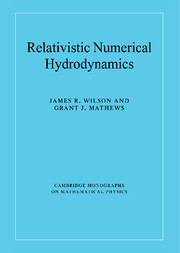4 - Cosmological hydrodynamics
Published online by Cambridge University Press: 11 January 2010
Summary
Most cosmology calculations utilize a homogeneous background spacetime in either a Friedmann–Robertson–Walker (FRW) metric or an equivalent extension. Calculations of local physical variables are treated as a perturbation on the background homogeneous expansion.
A natural question, however, is whether strong gravity waves in the early universe can cause a significant departure from this FRW treatment. There are also other cosmological questions which may require significant deviations from a FRW-plus-perturbations approach, such as the formation of primordial black holes, or the development of an inflating spacetime from inhomogeneous initial conditions. All such problems require the ability to solve for cosmological evolution in a metric more general than that of a simple perturbed FRW. Here we describe some attempts to model such cosmologies numerically.
Planar cosmology
In a linear numerical cosmology program was developed to study how strong waves might affect the physics of the early universe. In particular, the paradigms for inflation, nucleosynthesis, and microwave anisotropy have been analyzed in this context, along with the question of whether strong gravity waves steepen in the early universe. That is, the nonlinear nature of general relativity could cause colliding waves to produce an even stronger superposition wave. In spherical symmetry such superpositions can even form black holes.
The simplest cosmology to study is that of planar symmetry. A system with planar symmetry can have gravity waves. In one-dimensional simulations, physical quantities are restrained to vary in one direction, say z. All fluid quantities are then functions of z and t only.
- Type
- Chapter
- Information
- Relativistic Numerical Hydrodynamics , pp. 99 - 116Publisher: Cambridge University PressPrint publication year: 2003

